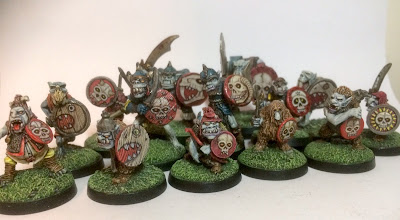 |
| About half the Monster Manual, I reckon ... |
In my last post, I suggested that CS Lewis's The Silver Chair is virtually a one-book Appendix N. I've been thinking a bit more about Narnia: specifically, just how like a D&D setting it is.
I should say that I've never been much of a Narnia enthusiast. I'd already read (or had read to me) The Hobbit and The Lord of the Rings by the time I came to Lewis. So, although I was the "right age" for The Lion, the Witch and the Wardrobe, it seemed a little thin by comparison. Shortly afterwards, I discovered Alan Garner's The Weirdstone of Brisingamen and The Moon of Gomrath, and Susan Cooper's The Dark is Rising and the rest of that sequence. Those books made Narnia seem even less satisfactory - a hodgepodge of elements plucked from all sorts of sources, rather than the deeper, more coherent and more resonant mythologies of Tolkien, Garner and Cooper.
But a hodgepodge of elements plucked from all sorts of sources is exactly what D&D is. And the coherence of the other settings makes them more aesthetically satisfying, but far less rich for gaming. If you play Merp, you're going to meet a lot of orcs and the occasional troll. Compare and contrast the White Witch's followers in The Lion, the Witch and the Wardrobe:
A great crowd of people were standing all round the Stone Table and though the moon was shining many of them carried torches which burned with evil-looking red flames and black smoke. But such people! Ogres with monstrous teeth, and wolves, and bull-headed men; spirits of evil trees and poisonous plants; and other creatures whom I won't describe because if I did the grownups would probably not let you read this book - Cruels and Hags and Incubuses, Wraiths, Horrors, Efreets, Sprites, Orknies, Wooses, and Ettins. In fact here were all those who were on the Witch's side and whom the Wolf had summoned at her command. And right in the middle, standing by the Table, was the Witch herself.Tom Fitzgerald of the marvellous (but sadly inactive) Middenmurk blog says this was the "most exciting passage of prose" for him when he was eight. I felt much the same about it - and was gratified when, after years of wondering, I realised that the Orknies must be the orcneas of Beowulf and the Wooses woses. Their accompaniment by the more familiar Ettins (eotenas in Beowulf) makes this clear.
But think of that passage in RPG terms. The White Witch appears to have at least seven or eight types of humanoid in her retinue, along with other nasty entities. Meanwhile, the forces of good include centaurs, fauns, satyrs, dryads, naiads, talking animals, unicorns and at least one giant. That's a fair old chunk of the Monster Manual.
Narnia matches D&D's assumed setting in various other ways too. Its courtly knights and castles, with their strong Arthurian whiff, sit side by side with creatures and gods out of Classical myth. There are fairy-tale creatures too, and select visitors from the Germanic tradition.
In Prince Caspian, we get the outline of a passable "dungeon" complex:
A little further on, in a dry, rocky ravine they reached the cave of five Black Dwarfs. They looked suspiciously at Caspian, but in the end the eldest of them said, "If he is against Miraz, we'll have him for King." And the next oldest said, "Shall we go further up for you, up to the crags? There's an Ogre or two and a Hag that we could introduce you to, up there."It's a description that has me itching for graph paper. The cave of the Black Dwarfs comes after a visit to the Seven Brothers of the Shuddering Wood, who are Red Dwarfs (nicer than the black-bearded sort, apparently). So in RPG terms, rather than a descent into successive levels populated by increasingly formidable adversaries, we have an ascent into territory inhabited by successively more malevolent creatures: benign Red Dwarfs, then ambivalent Black Dwarfs, then Ogres, then Hags.
This would be an interesting way to structure a 'megadungeon': ravines rather than corridors, and caves rather than rooms. Because the passes and ravines between the crags are open to the sky, wandering monsters could include flying beasts as well as emerging cave-dwellers. Doubtless, the worst nasties would live on or in the peaks.
And then, in The Voyage of the Dawn Treader, we get a marvellous 'island crawl'. This takes in an encounter with slave traders, a dragon's cave complete with hoard (and, eventually, a dragon), an uninhabited island, one with a dangerous magic pool, one populated by bizarre invisible creatures, one shrouded in darkness and one with enchanted inhabitants. There's an encounter with mer-people too. Turning the book into a mini-campaign would be very easy - so long as you could find players who hadn't read it. And you could probably raise a meta-gaming smile among players who had read it, if you disguised it sufficiently well at first. The slavers might be hobgoblins and the dragon a manticore, perhaps.
The other books - The Magician's Nephew (which has inspired noisms to create his There is Therefore a Strange Land setting), The Horse and His Boy and The Last Battle - all have their moments. But for all of the reasons I listed yesterday, The Silver Chair is the best of the lot.


























